














Rabone No 1207 six inch Rope Gauge made of boxwood and brass. UK Government 910/5193. Calliper measures diameter and also has a circumference scale so that that can be read directly. The table on the front is for breaking loads in tons for galvanised hawser steel ropes from one inch to five inch circumference. The table on the back is for weight and breaking load of 3 strand BSS grade 2 manila and sisal rope from one to ten inch circumference.
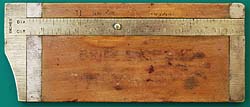
Rabone No 1206 four inch rope gauge. No tables. Promotional for Bridge Brand Steel Wire Ropes made by Bridgwater-Terrell Ropes Ltd, Bristol Road, Bridgwater, Somerset.
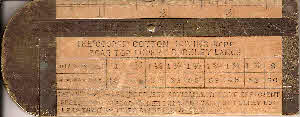
The ‘Cooper’ Cotton Driving Rope, Scar Top Ropery, Burnley, Lancs. Gauge made by John Rabone & Sons, Birmingham. The calliper slide has a circumference scale on the upper side and a diameter one on the underside. There is a table giving HP per rope against diameter under which it states: ‘The above are highest powers advisable at most efficient speed 4000 to 5000 ft per min with smallest pulley not less than 32 times diameter of rope.’
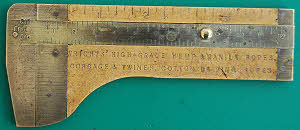
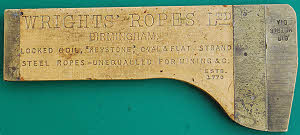
Calliper gauge made for Wright’s Ropes Ltd of Birmingham by I & D Smallwood. The slide is graduated for both diameter and circumference, in inches on the upper side, and metric on the under side. The scale length is 4 inches. Wright’s made or sold both steel and fibre ropes and were founded in 1770. This gauge is probably early 20th century. It is made of brass (lacquered originally) and boxwood.
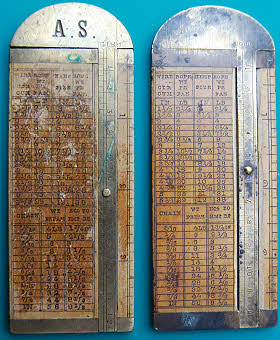
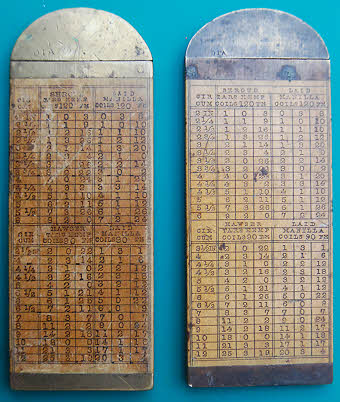


Two 4” and one 6” rope gauges. The left hand 4” one in both pictures is signed Edward Preston & Sons and the right hand one is by John Rabone & Sons. The 6” gauge is signed I & D Smallwood Ltd. All were Birmingham makers, and all have the same tables on them. In each case the slide has both circumference and diameter scales, both on the upper side on the 6” rule and one scale on each side of the slide for the 4” rules. The tables on the front side are: weight per fathom v circumference for wire rope, weight per fathom v size for hemp rope (units inches and pounds); chain (size) v weight per fathom & equivalent to hemp rope (inches, pounds, inches).
The tables on the back are: For shroud laid 120 fathom coils and hawser laid 90 fathom coils, tarred hemp and manilla ropes, weight in hundredweights, quarters and pounds v circumference.
A fathom was six feet, a hundredweight (cwt) was 112 pounds (lbs) and a quarter (qtr) was 28 pounds.

Rabone No 1460 four inch calliper rule made of boxwood and brass. Metric and inch scales.



Philip Harris & Co Limd Birmingham tape and leather strap gauge. It is actually a vernier calliper.
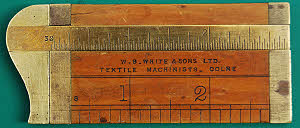
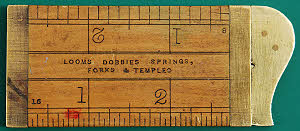
A three inch calliper rule by J Rabone & Sons made for W S White & Sons Ltd, Textile Machinists, Colne. On the reverse it says “Looms, Dobbies, Springs, Forks & Temples”.

Boxwood and brass 12” four fold calliper rule, probably made by Upson Nut & Standard Rule, Unionville, Ct, USA.

Two foot folding tailor’s square in wood and brass. It is signed ‘Roberts, Maker, Sheffield’. Three Roberts are known rule makers in Sheffield, viz: William Roberts (fl.1822-48), Richard Roberts (fl.1852), and Henry Roberts (fl.1868).
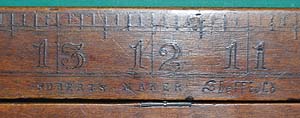


A boxwood & brass hatter’s rule for measuring the size of hats. The five inch long rule has an extending slide to measure the inside length and width. The table on the reverse then gives the hat size. Date and maker unknown but English and probably early 20th century or possibly late 19th.



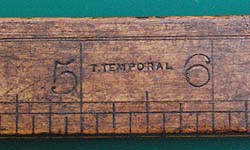
Shoe stick signed ‘T Temporal’, made of boxwood and brass.





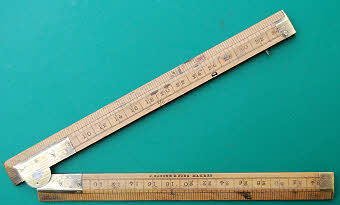
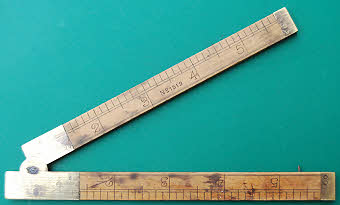
J Rabone & Sons tailor’s diagram square with a sixth scale (inches) on the upper face and an inches & eighths scale on the lower face. Probably used for drawing sketches in the tailor’s work book.


An ebony, ivory and nickel-silver hatter’s rule. It would have been considerably more expensive than the boxwood one above but is clearer to read. It only list 13 sizes in the table whereas the one above lists 16.
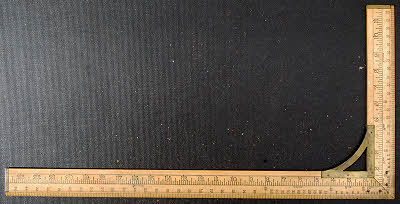
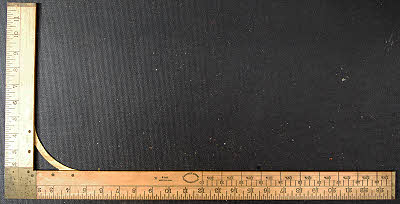
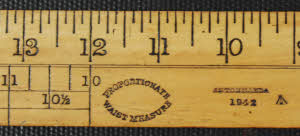
Aston & Mander 24” x 12” tailor’s square, signed “AstonManda 1942” made for the UK government in 1942. It is also marked “Proportionate Waist Measure” alongside that scale that can be seen to the left of it in the enlarged picture. The upper side has a bevelled edge with 1/16, 1/8, 1/4, 1/2, 1/12, 1/6, 1/3 scales on it. The inch rulers are divided into eighths on both faces. Boxwood and lacquered brass.





One foot, 3-fold, ironmonger’s rule signed John Rabone & Son on the edge. It dates from between 1845 and 1877. The table on the calliper face is a price per load table in £sd per cwt (hundredweight). The tables on the inner faces are weight tables for round, flat and square iron respectively in pounds and ounces per foot against size in inches. There is a ruler in inches and tenths alongside the tables. The rulers on the other faces are inches & eighths and inches & sixteenths.THe calliper measures inches & 32nds for the first inch and inches & 16ths for the remainder.


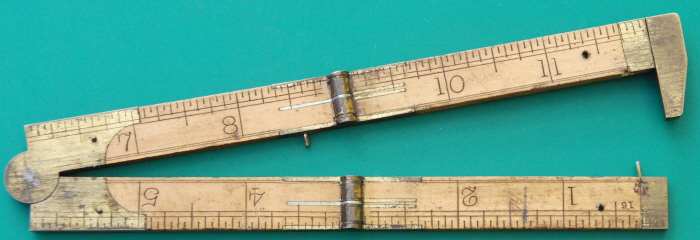
J Rabone and Sons four fold one foot calliper rule, boxwood & brass.
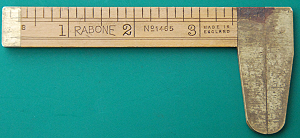
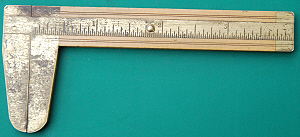
Rabone No 1465 four inch calliper gauge divided on the front face inches and eighths
and on the calliper inches and thirtyseconds. Boxwood & lacquered brass. Ca.1950s.
Rabone merged with Chesterman in 1963.


J Rabone & Sons combined rule, plumb and level. Patent no 22047. It was made in a
range of lengths including this 10 inch one. Various additional scales could be provided.
This has 1/2, 1/4, 1/3 and inch scales.


Two foot two fold boxwood and brass rule no 1390 branded Hockley Abbey (a Rabone
& Sons trade mark). The upper picture shows the ‘8 Square’ and ‘Line’ scales used
for marking out an octagonal section prior to rounding timber and the lower picture
shows the brass slide that extends the rule to 3 feet and can be used for depth measurement.
















































